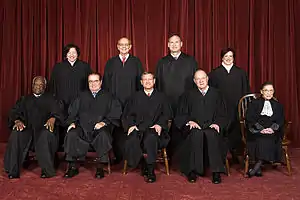Smith v. United States (2013)
Smith v. United States, 568 U.S. 106 (2013), was a case decided by the Supreme Court of the United States of America.[1] The case was argued on November 6, 2012 and decided on January 9th, 2013.[2]

| Smith v. United States | |
|---|---|
 | |
| Argued November 6, 2012 Decided January 9, 2013 | |
| Full case name | Smith v. United States |
| Docket no. | 11-8976 |
| Citations | 568 U.S. 106 (more) 133 S. Ct. 714; 184 L. Ed. 2d 570 |
| Argument | Oral argument |
| Case history | |
| Prior |
|
| Holding | |
| 9-0 in favor of United States. The burden of proof remains on the defendant to prove withdrawal from a conspiracy. | |
| Court membership | |
| |
| Case opinion | |
| Majority | Written by Justice Scalia |
Question of the Case
When a group has been charged with drug conspiracy, and several key members of the group claim they withdrew from the conspiracy at a point in time that would call into question the statute of limitations, is it the role of the government to prove that the drug conspiracy continued in a way that nullifies the statute of limitations? [1]
Facts of the case
There were six men, convicted through trial of several charges, including violations of the RICO act and drug conspiracy.[1] The specific statutes are 21 U.S.C. § 846 and 18 U.S.C. § 1962(d), where the prior regards attempt and conspiracy, and the latter regards prohibited activities.[2][3][4] The statute used in defense of Smith was 18 U.S.C. § 3282.[5] The case had been heard by the District of Columbia Circuit Court, which held that Smith should be convicted so long as the government had proven beyond a reasonable doubt the existence of conspiracy and Smith's involvement.[2] The court held that the jury should rule in favor of Smith if he proves that he withdrew from the conspiracy at a time appropriate to the statute of limitations, as the burden of proof was on Smith if the government proved his involvement in the conspiracy.[2]
Decision
In a unanimous decision, the court, with the majority opinion written by Antonin Scalia sided against Smith.[1] The court created a new precedent that presumes involvement in a conspiracy if the statute of limitations defense is used, shifting the burden of proof to the defendant.[2] The court determined that it is the burden of the defendant to prove that they withdrew from a conspiracy, and that they did so past the statute of limitations.[2] The Due Process Clause of The Constitution of the United States of America is not violated by putting the burden of proof on the defendant.[2] Though argued by the defendant, the court concluded that Mullaney v. Wilbur does not apply in this case.[6] Because Smith took part in a conspiracy, the defense of withdrawal is to be proven by the defendant, as it is assumed that he was a part of the conspiracy throughout.[6] The court also decided that innocence is not determined solely by withdrawing from a conspiracy, as withdrawal has to coincide with the statute of limitations.[2] To further understand the burden of proof on the government in accordance with the ruling, see Dixon v. United States.[7]
References
- "Oyez, Smith v. United States". www.oyez.org. Retrieved 2018-10-04.
- Smith v. United States, 568 U.S. 106 (2013).
- 21 U.S.C. § 846.
- .
- 18 U.S.C. § 3282.
- "Opinion analysis: When a defense is just a defense - SCOTUSblog". SCOTUSblog. 2013-01-14. Retrieved 2018-11-29.
- Dixon v. United States, 548 U.S. 1 (2006).
External links
- Text of Smith v. United States, 568 U.S. 106 (2013) is available from: Justia Oyez (oral argument audio) Supreme Court (slip opinion)